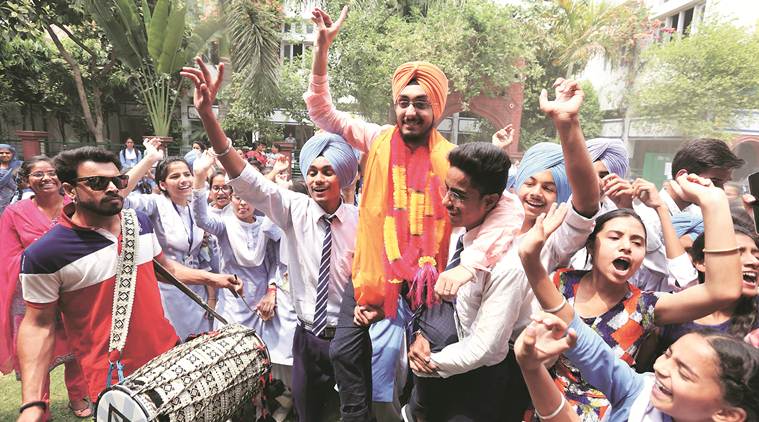The Punjab School Education Board (PSEB) inflated the pass percentage of class 12 students at least twice – in 2018 and 2019 – using the marks moderation policy (MMP), something that it claimed to have “scrapped”, an RTI reply has revealed.
In October 2017, the Ministry of Human Resource Development (MHRD) issued an “advisory” for state boards and the CBSE that there should be no “spiking or inflation” of marks for class 10 and 12 in order to improve overall results using Moderation policy.

The same policy had been used by the PSEB to bump up by more than 9 per cent the class 10 results declared this year, the Indian Express had reported in July.
As per the information obtained through RTI by Advocate HC Arora of Punjab and Haryana High Court, the class 12 pass percentage in 2018 was inflated by 9.84 per cent – from 56.13 per cent to 65.97 per cent – by giving five extra marks to students who had either failed or got re-appear/compartment in the results. Even the “original” 56.13 per cent pass percentage was prepared after giving “one per cent grace marks” to all the students.

Stream wise, 77.35 per cent commerce students, 55.03 per cent of humanities and 48.49 per cent of Science stream had cleared the exam without the MMP taking the overall pass percentage to 56.13 per cent.
The documents obtained through RTI reveal that after five extra marks given after applying MMP, the pass percentages were revised to 84.95 per cent for commerce, 65.11 per cent for humanities and 58.79 per cent for science stream. The overall pass percentage was thus inflated to 65.97 per cent.
Justifying the use of MMP in 2018, the PSEB says that in 2016, results of class 12 were declared after giving one per cent grace marks plus five more marks and the pass percentage was 76.65 per cent.
Story continues below this ad
Then on April 24, 2017, a meeting was held in Delhi to “review the policy of moderation of result of marks in secondary and senior secondary board examinations” and thus in 2017, results were declared only after giving one per cent grace mark. The class 12 pass percentage then was 62.34 per cent. However, it adds that according to “General Rules of Examinations, chapter-5, Moderation of Results, chairman can modify the results if pass percentage declines in comparison with two previous years”.
Further, for 2018, four options for extra marks were discussed – three marks (taking overall pass percentage to 62.11 per cent), five marks (65.97 per cent), seven marks (69.32 per cent), and 10 marks (70.28 per cent).
It was decided to go with the second option and give five extra marks for 2018.
The board justified using the MMP in 2018 as overall pass percentage was less compared to two previous years but it has failed to give any reason for why it was used in 2019 too when 80.85 per cent students (including open category) cleared the exam with “one per cent grace mark” and the result had improved considerably compared to previous year.
Story continues below this ad
The RTI reveals that 80.24 per cent had cleared humanities, 79.46 per cent science, 86.50 per cent commerce and 84.44 per cent vocational in 2019 with “one per cent grace mark”.
The board, however, using MMP, doled out three more marks. Stream wise the pass percentage for 2019 was inflated to 90.37 per cent in commerce, 86.40 per cent in humanities, 83.44 per cent in science, and 89.28 per cent in vocational.
The overall pass percentage, therefore, was inflated from 80.85 per cent to 84.33 per cent. The pass percentage of regular students was inflated from 83.11 per cent to 86.41 per cent.
Chief Minister Capt Amarinder Singh had lauded the education department for the “stupendous” results and claimed that there has been “considerable improvement” in education standards in Punjab since the Congress government took over in 2017.
Story continues below this ad
“This is a big fraud going on with people as well as students who are being kept in a misconception about their own ability just to show good results. Also, when almost all states have scrapped the MMP, how can Punjab still use it defying the Ministry of Human Resource Development (MHRD) guidelines. Even without moderation, 2019 results were way better than 2018, then why was this used?,” asked Arora.
Earlier, the RTI information had revealed that PSEB, using MMP, inflated class 10 pass percentage in 2018 and 2019. For 2019, it was inflated from 76.49 per cent to 85.56 per cent and in 2018 it was inflated from 46.29 to 62.10 per cent.
Sources in the PSEB told The Indian Express that MMP for both class 10 and 12 was used on the “direct interference of the state education department” which wanted the board “to improve the results”.
Despite repeated attempts, board spokesperson Raminderjit Singh Wasu, secretary Mohammad Tayyab and chairman Manohar Kant Kalohia did not respond to the calls.
Story continues below this ad
A government school teacher said, “Most of the teachers were shocked after seeing results because no one knows students better than their teachers. Students whom we knew will never pass, also cleared the exams. It was shocking and we knew something is fishy.”

 After class 12 results were declared this year. Archive
After class 12 results were declared this year. Archive































